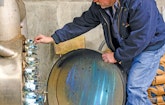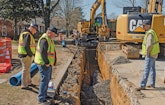A quick response to a water main leak is a high priority for the repair crew at Heber Springs (Arkansas) Water and Wastewater Utility. So is providing real-time updates about breaks in service to their customers.
When a crew heads out to a repair job, Noralee Mullady, social media coordinator, posts information about the main break on the utility’s Facebook page. A few hours later when the leak is repaired and water service is restored, she reports the repair in another announcement, alongside photos of the crew at work on the break.
It wasn’t always this way. In the old days, says Paul Graham, who took over as utility manager in May 2018, Heber Springs wasn’t so proactive in communicating with customers. “We tended not to respond to online complaints,” Graham says. “The feeling was we were just feeding those who would troll us out there. It wouldn’t do any good.”
Now, however, Graham feels the utility has a much better image in the community. “By responding quickly on social media, using our own Facebook page and website, we’ve really cut down on the negative publicity we used to get.”
Century of service
Heber Springs, 61 miles north of Little Rock, is accustomed to clean water. Nearby Greers Ferry Lake, known for its pristine shoreline and deep, crystal-clear water, is a 40,000-acre playground for fishing, boating and other water sports.
The town itself was founded as a health resort, and today is a popular site for vacation homes.
The Heber Springs Water and Wastewater Utility has provided both water and sewer service to the town since 1918, when the city passed an improvement bond and installed the first tile and concrete sewer lines, some of which remain in service. The utility staffs two separate crews: one responsible for drinking water, the other wastewater. The utility celebrated its 100th anniversary last year.
Greers Ferry Lake supplies the utility’s drinking water, which is directed to three different water treatment plants all at one location. “The old plant dates to the 1970s and consists of a downflow clarifier,” Graham says. In addition, the utility maintains two newer plants; one features upflow clarifiers, and the other was recently equipped with fully automated microfiltration membrane units from Pall Water — a $1.4 million project.
“We were just the second water treatment plant in the state of Arkansas to adopt microfiltration.” The membranes are mounted on two skids, with additional room for two more. Future plans are to phase out the clarifiers in favor of the membrane units.
“With microfiltration, we don’t have to use any coagulants such as alum,” Graham says, noting that savings in chemical costs amounted to approximately $53,000 during their first two months. “We still use aluminum sulfate and caustic soda for pH adjustment at the old plant.”
The utility uses sodium hydrochloride to meet its chlorine residual requirement. Total output for the three plants combined is about 8.4 mgd.
The distribution system consists of 146 miles of pipe, connecting approximately 10,000 customers and two wholesalers — Tumbling Shoals and Mountain Top Water.
Storage consists of seven aboveground tanks with a total capacity of 3.8 million gallons. Other tanks are planned and will increase capacity by another million gallons.
Fire suppression is top of mind with Graham. “We flush our system every six months and lube and turn our hydrants diligently. Our Fire Department is getting good ISO (Insurance Service Office) ratings, and we’re giving them a full 40 points on water supply.”
The Fire Department will also be celebrating 100 years in 2019, and the water utility presented the Fire Department with a commemorative table containing a special plaque made just for the occasion. “It was a token of our appreciation for its ongoing support,” Graham says.
Wastewater treatment
Wastewater from approximately 3,300 customers is treated in an older facultative lagoon system, capable of handling about 1.75 mgd. A 2019 bond issue will allow purchase and installation of a sequencing batch reactor to improve treatment and increase the treatment capacity to 4 mgd.
Currently, the wastewater passes through three sections in the pond, then is disinfected with UV light and released to the Little Red River, a high-quality trout stream.
“We’ve only had to dredge solids from the pond bottom once in more than 40 years,” Graham says.
The utility cleans its sewer mains as needed with a jetter and Vac-Tron. “Recently we purchased a PipeHunter jetter vacuum trailer that will assist us in sewer cleanings, as well as excavations around other utilities.”
Graham adds that the Arkansas Rural Water Association assists in sewer cleaning from time to time, especially with the utility’s older pipelines. “They come in and help inspect our system to find hidden issues in some of the older sewer mains.”
Improvement projects
As with most water/wastewater utilities across the nation, Heber Springs is engaged in a number of improvement projects aimed at providing better, more cost-effective services to its ratepayers.
On the clean-water side, Graham’s team is in the midst of laying a new high-pressure, high-volume transmission line through the center of town to supply its two water wholesalers, which normally use up to half the water produced by the utility. The pipeline will extend over 12,000 feet and be capable of handling water to 250 psi.
“We’re using class 350 ductile iron for the high pressures, C-900 DR-18 for the normal pressures,” Graham says. “We’re also adding a new pump station and new storage tank. When completed, the new line will give us two separate water arteries around the city that will feed only the wholesale customers.” That will relieve the strain on the rest of the system.
Utility crews are using conventional opencut excavation to install the new line.
Better meters
New and improved meters are another major advancement.
“In 2016, we replaced our old meter and meter-reading system with new technology from Badger Meter,” Graham says. The new system features Badger’s BEACON Advanced Metering Analytics cloud-based software suite coupled with Orion communication technology. Cost was $2.6 million, paid for through a bond issue.
“We are able to monitor and report every customer’s water usage within 24 hours using cellphones. The system uses existing cellphone towers and is synced to all the local service providers.
“Everyone’s individual water usage is available on the BEACON website,” he adds. “We can get alerts regarding leaks and water loss, and the customer is able to see those on an app called EyeOnWater.”
Not only has the new system saved time and manpower, it has reduced water loss by as much as 5 percent, Graham reports.
“In one case, a vacation home customer had a leak in a line to the swimming pool. Over 3,200 gallons per hour had been lost for about an eight-hour span, but we caught it and turned it off on a Sunday morning. We called the customer (in Memphis) and he was tickled to death.” Under the older system, the customer might not have known about the leak for up to 30 days when the meter was read again manually.
Graham says just one person is now dedicated to metering and is also responsible for turnons, turnoffs, cross-connection control and backflow testing. “We used to have two meter readers who spent about 20 days a month at that task.”
The new system reveals and prevents people stealing water from unoccupied homes.
Next generation
At the same time, the utility is making its sewer system ready for the next generation.
“We’ve budgeted about $250,000 a year for sewer maintenance and repair,” Graham says. “We have over 67.5 miles of pipe and 1,402 manholes, as well as 31 lift stations. This is a very hilly service area.”
The utility uses PVC pipe for most replacements. It has sliplined some pipes and is considering sliplining for more work in the future. “On our creek crossings, we use ductile iron.”
In the lift stations, the utility uses epoxy spray and injection molding from ICM Technologies. An expanding foam is injected in the ground and fills any cracks or holes in the manhole or lift station.
Heber Springs is also installing all-new electrical panels. “Previously, we’d repair or replace a bad panel with whatever we had in the shop,” Graham says. “As a result, we had different panels all over the place, requiring different parts for each.”
Now, the process is standardized and the panels are easier and cheaper to repair.
The utility is also installing new Barnes grinder pumps (Crane Pumps & Systems) and KSB submersible pumps.
Facing the public
All of these improvements are reported to the public through the utility’s Facebook page. Mullady updates the utility’s page at least twice a day.
“We post information on repairs and other events. Our crews take photos or videos and text them to me to post, or I can go out to a job site to take pictures.” She says it’s good for customers to see that utility workers are on the job, making the repairs.
“The guys tell me where they’re going to be. It’s not hard to do, and it keeps our customers aware of what’s happening: a road closure due to a holiday or if we’re flushing water mains in a section of the city.
“It’s exciting to see the water and wastewater utility evolve. We’re getting into the 21st century and we’re using technology to better inform our customers.”
Public relations and outreach is a major challenge, Graham says.
“We’re on Facebook with real people,” he says. “With our pictures and videos, our customers see us as real people — not faceless, nameless workers.”
He says it’s important to let people see what’s going on. “Using social media, we can pinpoint leaks and service work on our system map so customers can know where the leaks and job sites are. We head off possible complaints, and our employees’ families love it because they see their family members online. The morale among the crews has escalated.”
In Heber Springs, the public perception of the water and wastewater utility is changing for the better, Graham believes. “People just want to be in the loop.”
An experienced team
Staff members at the Heber Springs Water and Wastewater Utility have earned their positions from the ground up. Some have worked their way up from belowground.
Paul Graham, general manager; Tom Stanford, operations manager; and Joey Massey, wastewater treatment plant manager, all started out as ditch hands with the utility. The hands-on experience extends to Sam Querry, assistant manager, who was the utility’s first wastewater treatment plant operator and Randy White, water treatment plant manager, who started as a meter reader.
Graham remembers working in the sewer ditch for 10 months before being promoted to meter reader for the next nine years. In 2013, Graham — a licensed master plumber — was promoted to distribution crew supervisor. He was promoted to assistant general manager in 2016 and general manager in 2018.
He holds Grade 4 wastewater treatment, water treatment and water distribution licenses. He is also a part-time captain of the Heber Springs Fire Department.
Querry is the longest serving member of the team, having joined the utility in 1979. After five years as a crew member, he became manager of the wastewater treatment plant when it transitioned from a storage lagoon to filters and UV disinfection in 1983. He was promoted to assistant manager in 2008. He holds Grade 4 water treatment, water distribution and wastewater treatment licenses.
After serving as a ditch hand on the maintenance crew, Stanford was promoted to equipment operator, then moved up to water treatment plant operator and finally became operations manager in 2013. He oversees all field operations, including taps, leaks and new construction; the sewer crew and the water crew as well as the utility’s mechanics; and the training, safety programs and inventory programs.
He holds Grade 4 water treatment and water distribution licenses and a Grade 3 wastewater treatment license.
White joined the team in 2000. After reading meters, he became the utility’s inflow and infiltration inspector, charged with inspecting all new water main and sewer construction and installing flowmeters on sewers. He became water treatment plant manager in 2012, supervising two employees and ensuring the plant meets or exceeds all government standards.
He holds Grade 4 water treatment and water distribution licenses and a Grade 3 wastewater treatment license.
Massey was promoted to equipment operator two years after he was hired in 2004. In 2012 he was promoted to the wastewater treatment plant as a plant operator, a position he held until 2018 when he was named plant manager. He supervises a staff of two and makes sure the operation is covered on weekends.
Massey holds a Class 3 wastewater treatment license.
“We’ve built a team of professionals in all of the crucial roles and have given them the ability to get the job done,” Graham says. He believes in giving his employees the opportunity to earn the licenses needed to be able to go to any utility and find a job. “But at the same time, we want to promote a workplace that encourages the employee to want to stay at Heber even if they are offered a better-paying job somewhere else.”











